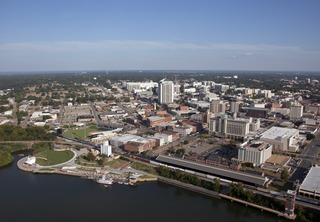
Montgomery is the capital city of the U.S. state of Alabama and the county seat of Montgomery County. Named for Continental Army Major General Richard Montgomery, it stands beside the Alabama River, on the coastal Plain of the Gulf of Mexico. The population was 200,603 at the 2020 census. It is now the third most populous city in the state, after Huntsville and Birmingham, and is the 128th most populous in the United States. The Montgomery Metropolitan Statistical Area's population in 2022 was 385,460; it is the fourth largest in the state and 142nd among United States metropolitan areas.

Eufaula is the largest city in Barbour County, Alabama, United States. As of the 2010 census the city's population was 13,137.

Lowndesboro is a town in Lowndes County, Alabama, United States. At the 2010 census the population was 115, down from 140 in 2000. It is part of the Montgomery Metropolitan Statistical Area. Although initially incorporated in 1856 by an act of the state legislature, it lapsed and was not reincorporated until 1962.

Elmira College is a private college in Elmira, New York. Founded as a college for women in 1855, it is the oldest existing college granting degrees to women that were the equivalent of those given to men. Elmira College became coeducational in all of its programs in 1969. As of 2023, the college has an enrollment of approximately 657 students.

The Alabama State Capitol, listed on the National Register of Historic Places as the First Confederate Capitol, is the state capitol building for Alabama. Located on Capitol Hill, originally Goat Hill, in Montgomery, it was declared a National Historic Landmark on December 19, 1960. Unlike every other state capitol, the Alabama Legislature does not meet there, but at the Alabama State House. The Capitol has the governor's office and otherwise functions as a museum.

Loews Philadelphia Hotel, previously known as the PSFS Building, is a skyscraper in Center City, Philadelphia, Pennsylvania. A National Historic Landmark, the building was the first International style skyscraper constructed in the United States.

The Morocco Temple is a historic Shriners International building in Jacksonville, Florida. It is located at 219 Newnan Street, and was designed by Jacksonville architect Henry John Klutho. On November 29, 1979, it was added to the U.S. National Register of Historic Places. The building is the oldest Shrine temple in Florida.

Houston Hall is the student union of the University of Pennsylvania, in Philadelphia, Pennsylvania. Completed in 1896, it was the first student union built on an American college campus.
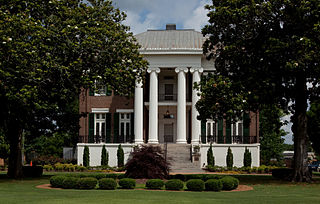
Rogers Hall, also known as Courtview, is a three-story antebellum house at 500 Court Street in Florence, Alabama. It was built by enslaved people from 1854 to 1855. It is one of the oldest historic landmarks on the University of North Alabama campus and one of the university's most distinctive structures. The building was recorded by the Historic American Buildings Survey from 1934–35. It was listed on the National Register of Historic Places on June 13, 1974.

The William Lowndes Yancey Law Office is located at the corner of Washington and Perry Streets in Montgomery, Alabama. It served as the law offices for one of the South's leading advocates of secession from the United States, William Lowndes Yancey, from 1846 until his death in 1863. He joined with John A. Elmore to form a legal firm after his resignation from Congress on 1 September 1846. Yancey wrote Alabama's Ordinance of Secession after the election of Abraham Lincoln and subsequently served as the Confederacy's Commissioner to England and France.
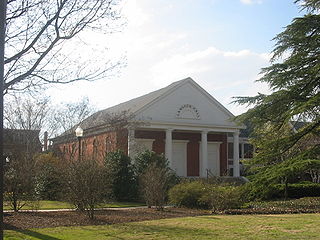
Langdon Hall is a building on the campus of Auburn University in Auburn, Alabama, United States. Built in the Greek Revival style in 1846 as the chapel for the Auburn Female College and moved to the Auburn University campus in 1883, Langdon Hall is the oldest building in the city of Auburn, and today houses an auditorium and office space for Auburn University staff. Before the Civil War, Langdon Hall served as the location for a series of debates on the question of Southern secession, involving William Lowndes Yancey, Alexander Stephens, Benjamin Harvey Hill, and Robert Toombs. Langdon Hall is named for Charles Carter Langdon, a former mayor of Mobile, Alabama, Alabama Secretary of State, and a trustee of Auburn University from 1872–1889.

McMillan Hall is a building on the campus of Washington & Jefferson College in Washington, Pennsylvania, United States. Built in 1793, it is the only surviving building from Washington Academy. It is the eighth-oldest academic building in the United States that is still in use for its original academic purpose and is the oldest surviving college building west of the Allegheny Mountains.

The Frank M. Johnson Jr. Federal Building and United States Courthouse is a United States federal building in Montgomery, Alabama, completed in 1933 and primarily used as a courthouse of the United States District Court for the Middle District of Alabama. The building is also known as United States Post Office and Courthouse—Montgomery and listed under that name on the National Register of Historic Places. In 1992, it was renamed by the United States Congress in honor of Frank Minis Johnson, who had served as both a district court judge and a court of appeals judge. It was designated a National Historic Landmark in 2015.
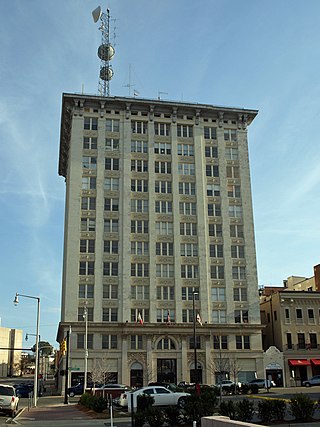
The Bell Building is an office building located in downtown Montgomery, Alabama. It was built in 1907 by local businessman Newton J. Bell, and was the tallest building in Montgomery at the time. It was added to the National Register of Historic Places in 1981. The height of the building is 187 feet.

The Gorgas–Manly Historic District is a historic district that includes 12 acres (4.9 ha) and eight buildings on the campus of the University of Alabama in Tuscaloosa, Alabama. The buildings represent the university campus as it existed from the establishment of the institution through to the late 19th century. Two buildings included in the district, Gorgas House and the Little Round House, are among only seven structures to have survived the burning of the campus by the Union Army, under the command of Brigadier General John T. Croxton, on April 4, 1865. The other survivors were the President's Mansion and the Old Observatory, plus a few faculty residences.
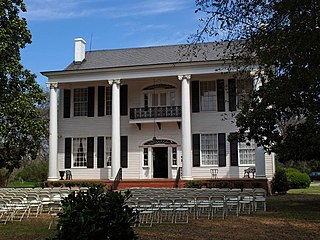
The Montgomery–Janes–Whittaker House, best known today as Buena Vista, is a historic Federal style plantation house in Autauga County, Alabama, south of Prattville. It was listed on the National Register of Historic Places on October 25, 1974. The house is currently owned by the Autauga County Heritage Association and operated as a historic house museum.

Auburn City Hall in Auburn, Alabama, built in 1933, is the city hall of Auburn, Alabama. It was originally constructed as a post office in 1933, and, like many post offices constructed during the Great Depression, the building has a "starved classical" design typical of federal architecture, with symmetrical style and pointed pediments and elements of colonial revival architecture. It was listed on the National Register of Historic Places as the U.S. Post Office in 1983.
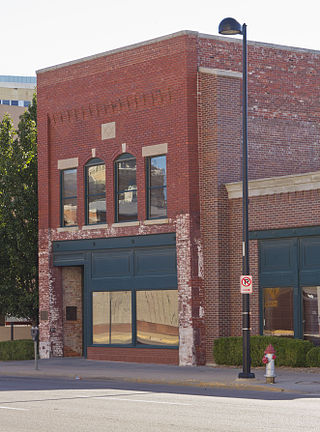
The Arkansas Valley Lodge No. 21, Prince Hall Masons is a historic building in Wichita, Kansas. The lodge was chartered in 1885.

The Scanlan Building is a building in Downtown Houston.

The Rose Realty-Securities Building is a historic six-story building in Omaha, Nebraska. It was built by John H. Harte for the Rose Realty Company in 1916, and designed in Chicago school style by architect Frederick A. Henninger. The first floor was used for stores while the upper floors were rented as offices. The corner of 16th and Farnam was a Union Pacific ticket office from 1917 to 1941. The building has been listed on the National Register of Historic Places since July 19, 1996.























